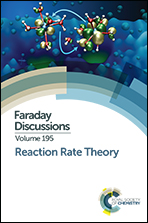Photorelaxation of imidazole and adenine via electron-driven proton transfer along H2O wires†
Abstract
Photochemically created πσ* states were classified among the most prominent factors determining the ultrafast radiationless deactivation and photostability of many biomolecular building blocks. In the past two decades, the gas phase photochemistry of πσ* excitations was extensively investigated and was attributed to N–H and O–H bond fission processes. However, complete understanding of the complex photorelaxation pathways of πσ* states in the aqueous environment was very challenging, owing to the direct participation of solvent molecules in the excited-state deactivation. Here, we present non-adiabatic molecular dynamics simulations and potential energy surface calculations of the photoexcited imidazole–(H2O)5 cluster using the algebraic diagrammatic construction method to the second-order [ADC(2)]. We show that electron driven proton transfer (EDPT) along a wire of at least two water molecules may lead to the formation of a πσ*/S0 state crossing, similarly to what we suggested for 2-aminooxazole. We expand on our previous findings by direct comparison of the imidazole–(H2O)5 cluster to non-adiabatic molecular dynamics simulations of imidazole in the gas phase, which reveal that the presence of water molecules extends the overall excited-state lifetime of the chromophore. To embed the results in a biological context, we provide calculations of potential energy surface cuts for the analogous photorelaxation mechanism present in adenine, which contains an imidazole ring in its structure.
- This article is part of the themed collection: Reaction Rate Theory


 Please wait while we load your content...
Please wait while we load your content...